This resulted in a very particualar situation. Different organizations came into possesion of a great operating system with which they were able to do whatever they pleased. The original creators, AT&T were unable to sell the software. Of course, they wanted to monetize this opportunity.
This chapter of history is convoluted, so hopefully I won’t make any significant errors here. Most of this history would be lost to time, if it it wasn’t for dedication of dedicated fans. Remember, I try to link sources so please go take a visit to their sites and talks. But please, go and see Warner Hosh’s talk on the early history of UNIX. It’s a gold mine and guiding light allowing me to write the following chapter.
Other Bell Unixes
The first forks (separately developed versions of Unix) came from Bell1.
AT&T was, as we remember, a telephone company. Lots of wires coming into centralized buildings, called switches. The first known fork of Unix was intended to automate switching of connections, therefore the very long name - New Jersey Bell Switch Control Center System (/NJ Bell SCCS). This version of /Unix is the earliest known usage of the OS family outside of Bell Labs. It was released in 1971 as a fork of 1st or 2nd edition of Unix and was the first known Unix to support inter-process communication and file locking. Those advancements were not back ported to mainline Unix until System V2,1. This version of Unix evolved into Columbus Unix (CB-Unix), as the SCCS Unix was developed by Bell Division 59473 in Columbus, Ohio.
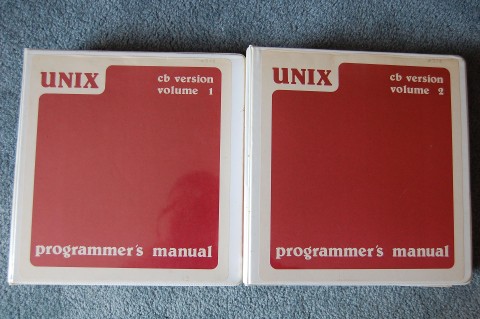
In a completely different part of Bell Labs, another project was starting to use Unix. Mert (Multi-Environment Real-Time3) was a fork for use in embedded minicomputers, like PDP-11s4. And so in 1973 Unix V4 was ported to run as a supervisor on DEC PDP-11 computers, models -11/45 and -11/70 5. It was the first time Unix was run in a virtualized environment1,4. To achieve this, authors used a new (at the time) idea that we now call microkernel. This system evolved later into Unix/RT and then DMERT
Yet another version was PWB/Unix which was designed to be used to create software for batch processing. This was how processing was done back then - you created your program, submitted it to a mainframe, but with the use of Unix no longer one needed to provide a deck of cards to a operator. As a result, PWB provided an early version of Source Control System. To make work easier, this was the first version to include a shell - pwb shell. Other tools we know and love today that originate in PWB are awk, sed, grep, or make1. Ergo, this was one of the OSes made for work, not for research. This OS was released in 1977 but Evan Ivie and Rudd Canaday started working on it in 19736.
In the same year, 1973, Bell funds a small group to support the use of Unix across the lab - the UNIX Support Group or USG for short7. Their version of Unix was called Unix/TS and was based on UNIX v4. It was later merged with PWB and 32V to become Unix/TS 3.0 known also as System III. After another merge, this time with CB-Unix and it became Unix/TS 4.0, which however was never released. The next version after that, Unix-TS 5.0, became the System V.1,7.
We’re not done yet. UNIX has seen its share of history and we’re still in the 70s. 1975 saw the release of MUNUX, most likely as a fork of UNIX V51. It was a modification of mono-processing system, UNIX, to multiprocessing utilizing two PDP 11/508. Yes, multi processor processing was researched in the 70s.
UNIX V6 saw the addition of BBN TCP/IP Stack in 1977. This is worth mentioning, as before that Bell labs pretended that packets are to be ignored, as networking is to be done using circuit switching. AT&T was a telephone company after all1. V6 from 1975 introduced yet another feature - commercial license. We will get back to that, but it is what sounds like: AT&T is earning money from Unix.
AUSAN and the birth of BSD
AUSAM, the Australian Unix Share Accounting Method was the first community maintained fork of Unix based on the Sixth Edition1. The work conducted at Universities of Sydney and New South Wales focused on allowing the system to run with huge number of users9. The changes returned to Unix V7, but AUSAM was never upgraded to a full 7th ed1
In 1975, Ken Thompson took a sabbatical and took a teaching job at the University of California at Berkeley, where he helped install Version 6 of Unix. The OS received quite the attention of students and faculty, resulting in the first version of BSD Unix - 1BSD. The lineage of BSD is extensive (not to mention their descendants are what I use) and will be a subject of the next part of our story. For now, remember that BSD exists. The name will be all over the place, but proper history of BSD lineage deserves a deeper look.
The Unixes we’ve talked about here were research projects. People tried to understand what can be done with a Computer using Unix as the base. But no one was stopping other people from earning money. So they did.
The first wave of commercial Unixes were mostly ports allowing to run Unix on wide range of hardware. Remember, this was way before X86 destroyed the scene and computers, there were vastly different computer architectures on the market. It was no small feat, and this is the hobby of a lot of folks in IT. Doom is supposed to be ported to everything that can compute. The good old IBM PC got 386/IX (aka PC/386) in 198410. Amigas got their Amiga Unix in 1990 developed by Commodore-Amiga, Inc./. HP’s internal line of mainframes were given HP-UX (sometimes called HP-SUX) in 1984. Most of those don’t have any value now, but it’s important thread in our story.
Solaris
However some of those forks have huge value. Sun Microsystems (murdered by Oracle buyout) offered their own line of workstations. Their Unixes were initially based on BSD under the name of SunOS - versions 1 to 4.1.4. Starting with version 5 however, the base OS was changed to System V and the OS renamed to Solaris. Up to this day, this one of the most well remembered OSes. Mind you, it’s still developed (in 2023), but people simply don’t want to do anything in proximity to Oracle.
Xenix
Some Unixes are remembered for very different version. Xenix, first released in 198011 was a fork for IBM/PC, Apple Lisa, Tandy (amongst others) released and developed by Microsoft. Yes, a timeline exists where Windows never became the standard, and instead a MS branded Unix rules the land. The first version is said to be very close to System 7, but with time more and more changes were applied. It was quite the buzz in the buzz, even Intel sold a complete computers with Xenix preinstalled under the name System 86. Measured by number of machines on which it was installed, Xenix was the most common Unix variant by the mid-to-late 1980s12 Nothing of this mattered in the death march of Windows, and the last version was released in 1991.
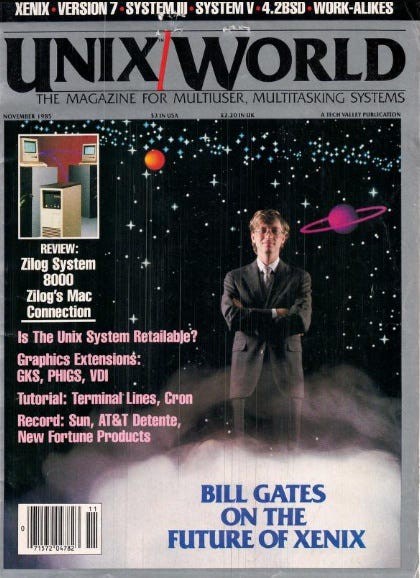
AT&T Strikes Back
None of the systems developed outside of AT&T could use the name Unix, as the it was a trademark. The management of AT&T was paying attention and starting to get hungry. However, by 1980s, the most popular variant of non-commercial Unix was BSD13.
The Unix landscape was like nothing else. Despite companies sharing up to 90% of code, all the Unixes were incompatible. Hardware and software vendors were unable to support all of them. The was no Single Unix, which made it the adoption much slower and painful. In 1981 Ma Bell (Mother Bell, a common colloquial name for Bell companies) helped a bit by combining all of Bell’s Unixes into a single one - Unix System 3. Its binaries were sub-licensed for 100USD. Nothing big enough to trigger legal actions, but Bell Unix became a commercial product.
This could not go like this forever.
The change came from no one other, but the U.S. Department of Justice. The year is 1983 and the second antitrust case against AT&T is settled, causing the breakup of Bell System. This removed the decree from 1956 and AT&T was able to commercialize Unix. AT&T swiftly introduced the (aforementioned) Unix System V (note the lack of System IV). You could now buy an AT&T Unix for the low price of $43,000, though it allowed for commercial usage of the source code. Of course, add-ons (like networking) were sold separately. This product received its own division within AT&T - AT&T Information Systems, later Unix System Laboratories or USL14.
AT&T intended System V to be the standard way to experience Unix, but others disagreed. The situation on the battlefield was complex, with different players putting their figures all over the place. We had two behemoths - AT&T with System V and Berkeley University with BSD, now on version 4.2 plus a lot of smaller players. AT&T had all the money and name to crush anyone but did not support networking. BSD had a TCP/IP based networking and was popular among st universities.
Vendor were choosing sides - IBM and HP went with System V while others, like Sun choose BSD. Some were trying to get it both ways - Pyramid’s OSx supported syscalls of both, BSD and System V15.
On 27th of March, 1984 AT&T officially enters computer market with their own line of computers from desktops PCs to “super-microcomputers” powered by Unix14.
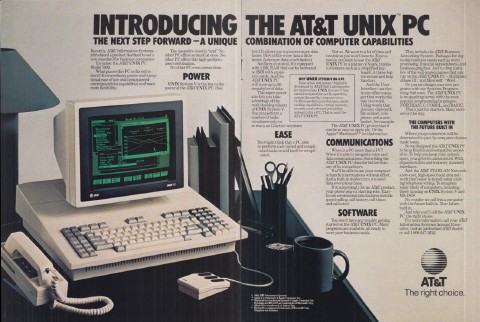
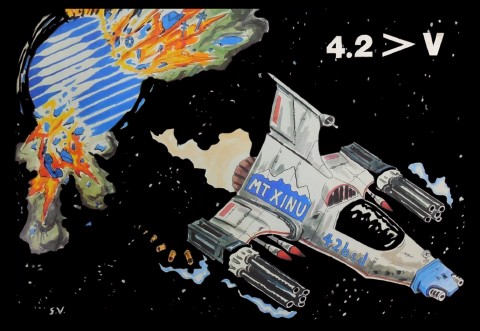
BSD on the verge
The rules of the game also changed. All Unixes shared code originating from Bell Labs, but AT&T was not happy with this. Therefore, while BSD still could be used for research purposes, any commercial usage would require first purchasing rights for System V usage. The system came with license agreement allowing only for usage in academic institutions and purposes.
By 1980s features of BSD were adopted back in System V. This, and the license made users and vendors flock towards AT&T, since they had to get a license anyway. Even curriculum was changed, since distributed source code of Unix (be it during lectures or in text books) were under AT&T control14. This made Lions Commentary on UNIX the most photocopied book in academic history. Owning Nth generation, barely readable copy gave significant bragging rights1.
Alliances - X/Open, AT&T&Sun, OSF, UI
All of this made Unix suffer. People were not writing software for it, since all flavors were incompatible.
Seeing the situation, a number of companies joined forces to create a single standard . In 1984 the Open Group for Unix Systems was formed by the likes of Bull, ICL, Siemes, Olivetti, and Nixdorf. The group was commonly known as BISON, from first names of their name. Later, the name was changed to X/Open.
The group decided to base their standard on System V because they “decided to run the risk of exploitation by AT&T rather than by IBM”16. The first version of the specification, X/Open Portability Guide Issue 1 was published in 1985 and “covered basic operating system interfaces”17.
The situation was, however, dire. In 1985 MS-DOS had 5x the number of applications compared to Unix. This lead to the year 1986, and AT&T took a $1.2 billion loss, with half of that in computer industry.
In 1987 AT&T and Sun enter an agreement. Sun, by that time, was the largest Unix vendor with SunOS based on BSD 4.2 and their own line of RISC-based microprocessors - SPARC. The official note stated that they are joining forces to “pursue co-development of a standard Unix operating system based on AT&T’s System V, Berkeley’s BSD 4.2, and the graphical capabilities of Sun’s SunOS”17.
The computer world was not happy with those giants creating their own front. The fear was that it could lead to a total domination of the market by AT&T OS running on Sun hardware. DEC engineer Armando Stettner, said:
“When Sun and AT&T announced the alliance, we at Digital were concerned that AT&T was no longer the benign, benevolent progenitor of UNIX…Sun was everyone’s most aggressive competitor. We saw Sun’s systems were direct replacements for the VAX. Just think: the alliance combined our most aggressive and innovative competitor with the sole source of the system software — the balance shifted.”17, 18
This lead to the creation of third combined group - in 1988 representatives from Apollo, DEC, Gould Electronics, Hewlett-Packard, Honeywell-Bull, InfoCorp, MIPS, NCR, Silicon Graphics, UniSoft, and Unisys met in DEC’s office in Palo Alto. Initially the group called themselves Hamilton Group (from Hamilton Avenue, where DEC offices were located). Their goal was to get AT&T on board, but it failed.17 As a reaction, they invited IBM who happily joined and in May of 1988 they official announced their existence under the name of Open Software Foundation (OSF).14 They decided not to base their standard on AT&T:
“Unlike X/Open, OSF planned to produce an operating system that it would license to its members, rather than function only as an advisory body.”17
This had the historic effect of putting rivals, DEC and IBM on the same side. DEC co-founder, Ken Olsen never before shared a stage with any IBM executive before. Even Ken Thomson while traveling in Australia commented on this to Dennis Ritchie:
“Just think, IBM and DEC in one room. We did it!”14.
Sun’s CEO, Scott McNealy was not as pleased, as he called the OSF the “Oppose Sun Forever”. The heat lead to AT&T and Sun creating Unix International, whose goal was to advise AT&T on System V and promote its development. The voting rights were based on, of course, financial contributions17.
OSF faced internal problems due to consisting parties often competing on the mainframe market. This left OSI and UI as the dominant powers in the straggle, and in total they ended with over two hundred members. Both also developed and released their own Unixes. In November of 1989 AT&T releases a commercial version of System V Release 5, and in 1990 the OSF released OSF/1 based on IBM’s AIX and Carnegie Mellon’s MACH operating systems17
Enemy mine
The battle continued into 1990s, and there was no sign of a clear winner. First, the economy turned to the worst with the early 1990s recession in the US. Most players of the Unix Wars, as we call them now, started seeing decrease in profit - sometimes loses. Second, 1993 saw the release of Windows NT, which was aimed directly at the market Unix was fighting for. Having a single, widely supported OS allowed Microsoft to quickly gain huge market share.
Unix fought with more standardization attempts.
Firstly, in 1988 the IEEE 1003 was released, Portable Operating System Interface, aka POSIX.
The second was known as Common Open Software Environment, the COSE. It was one more attempt to create an open, unified, standardized Unix. This time, however, it was not a fight between Unix vendors. This was the first time they had to unite against a common enemy. Initially the group consisted of The Santa Cruz Operation, Unix System Laboratories, Univel, Sun, HP, and IBM They tasked themselves not with creating of a single unified OS, but rather with survey and document what already was there. The result of their work is Spec 1170, now known as Single Unix Specification.17, 19
This lead to the last attempt. In 1996 OSF and X/Open merged and became The Open Group which exists till today. It was however too late for Unix to regain its dominance. The value was lost, the Unix wars saw the rise of Microsoft and a new player - GNU/Linux.
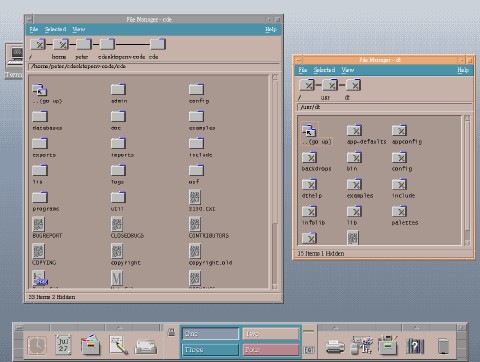
The trademark of Unix resides now with The Open Group which is responsible for certification of products. It’s quite expensive, so now we have two types of OSes in our lineage: Unix (with certification, like MacOS) and Unix-Like (following all requirements, but not certified - like GNU/Liunux). The Open Group develops a very large volume of specifications under the name of POSIX (The Portable Operating System Interface).
-
The hidden early history of unix the forgotten history of early unix ↩︎ ↩︎ ↩︎ ↩︎ ↩︎ ↩︎ ↩︎ ↩︎ ↩︎ ↩︎
-
Yes, virtualization is not a new idea as it dates back to the 60s when IBM designed the System/360 to emulate other devices, like the 1401. ↩︎
-
Unix Support Group on Gnukies ↩︎ ↩︎
-
MUNIX, A MULTIPROCESSING VERSION OF UNIX by John Alfred Hawley, Naval Postgrade School, June 1975 ↩︎
-
A Chronicle of the Unix Wars by Asianometry on Youtube ↩︎ ↩︎ ↩︎ ↩︎ ↩︎
-
Piramid Technology on Wikipedia ↩︎
-
UNIX STANDARDS IN THE 1990s on University of Michigan ↩︎
-
The Daemon, the GNU and the Penguin by by Peter H. Salus ↩︎
 History of Unix
History of Unix